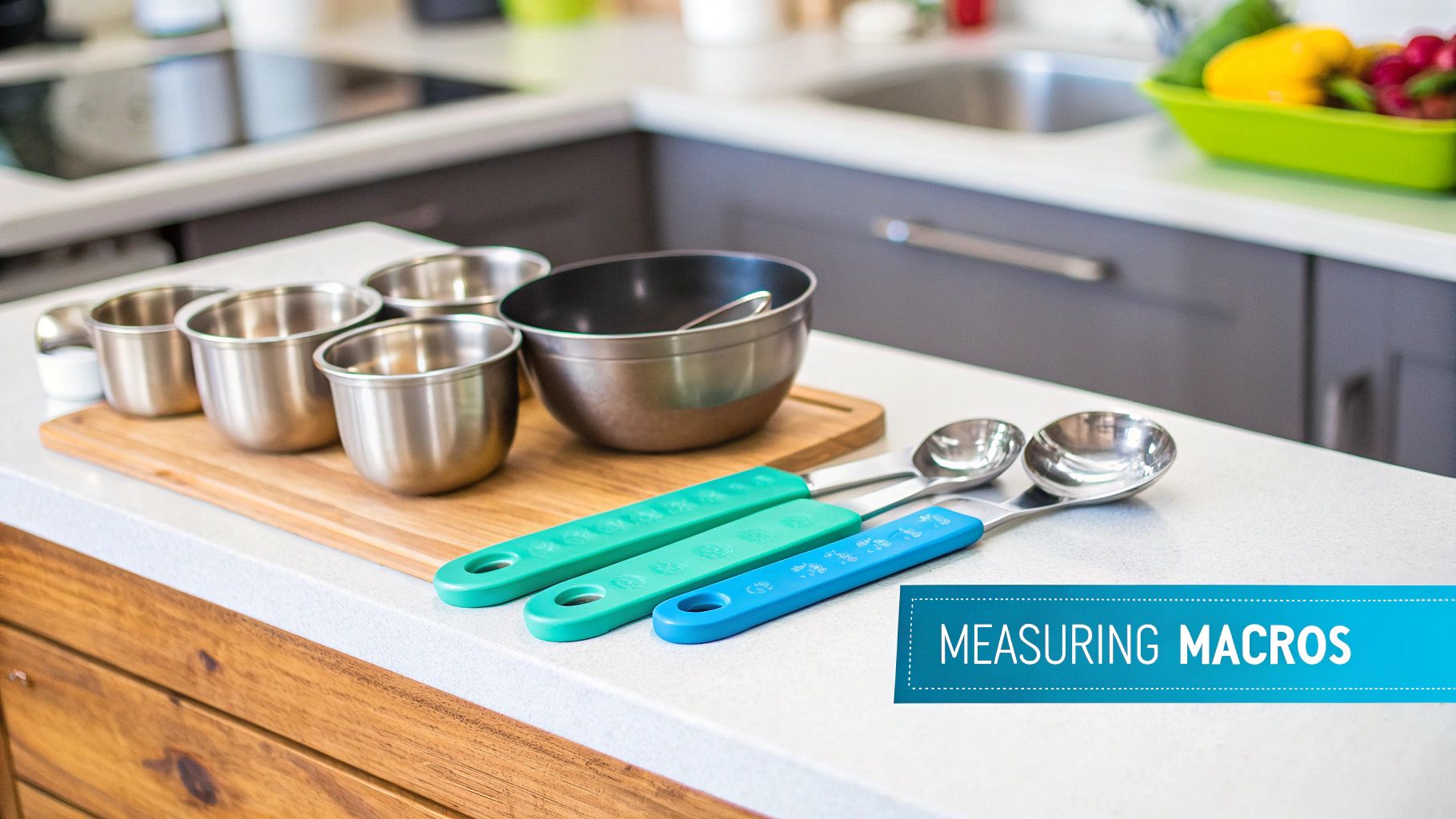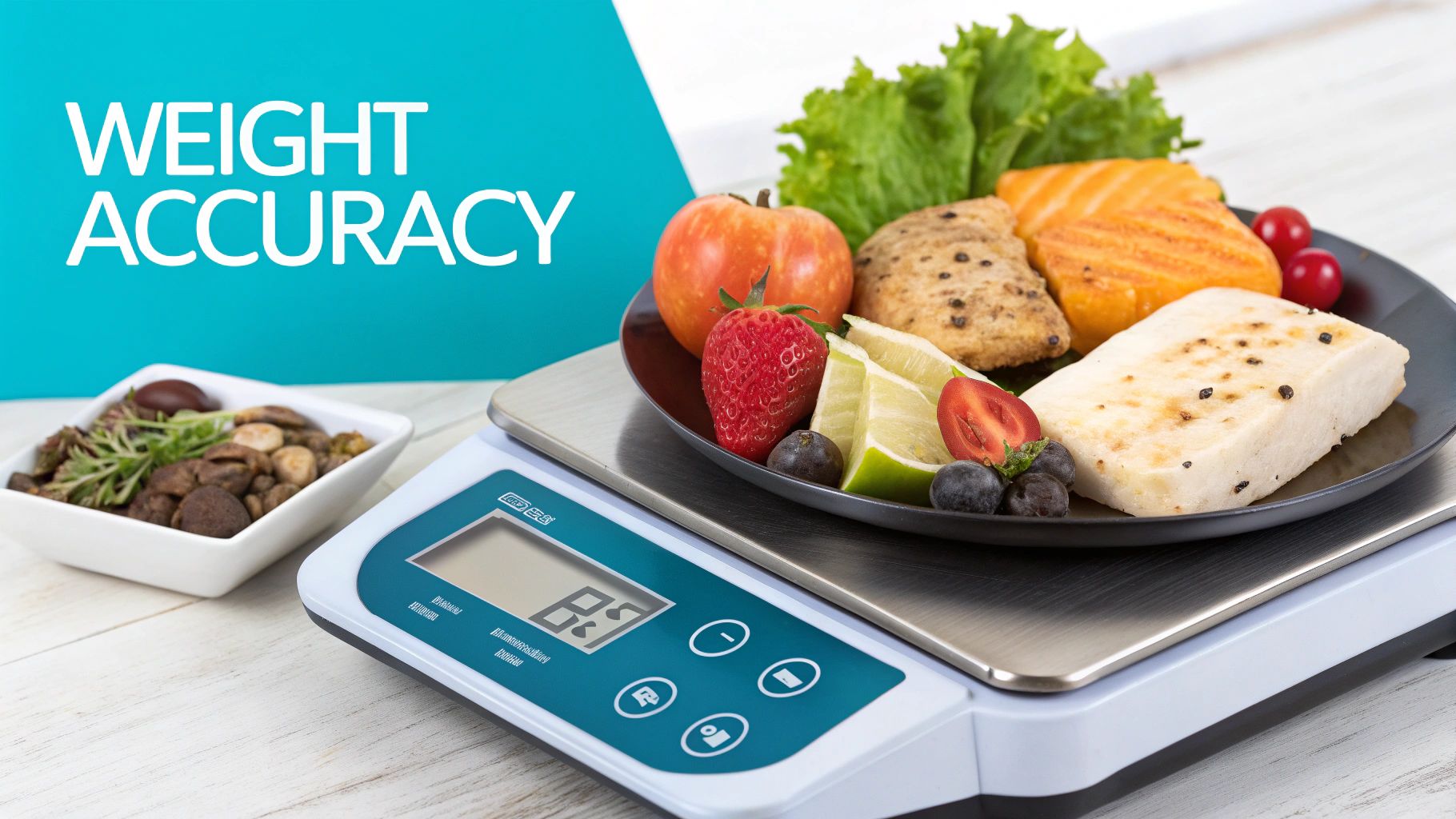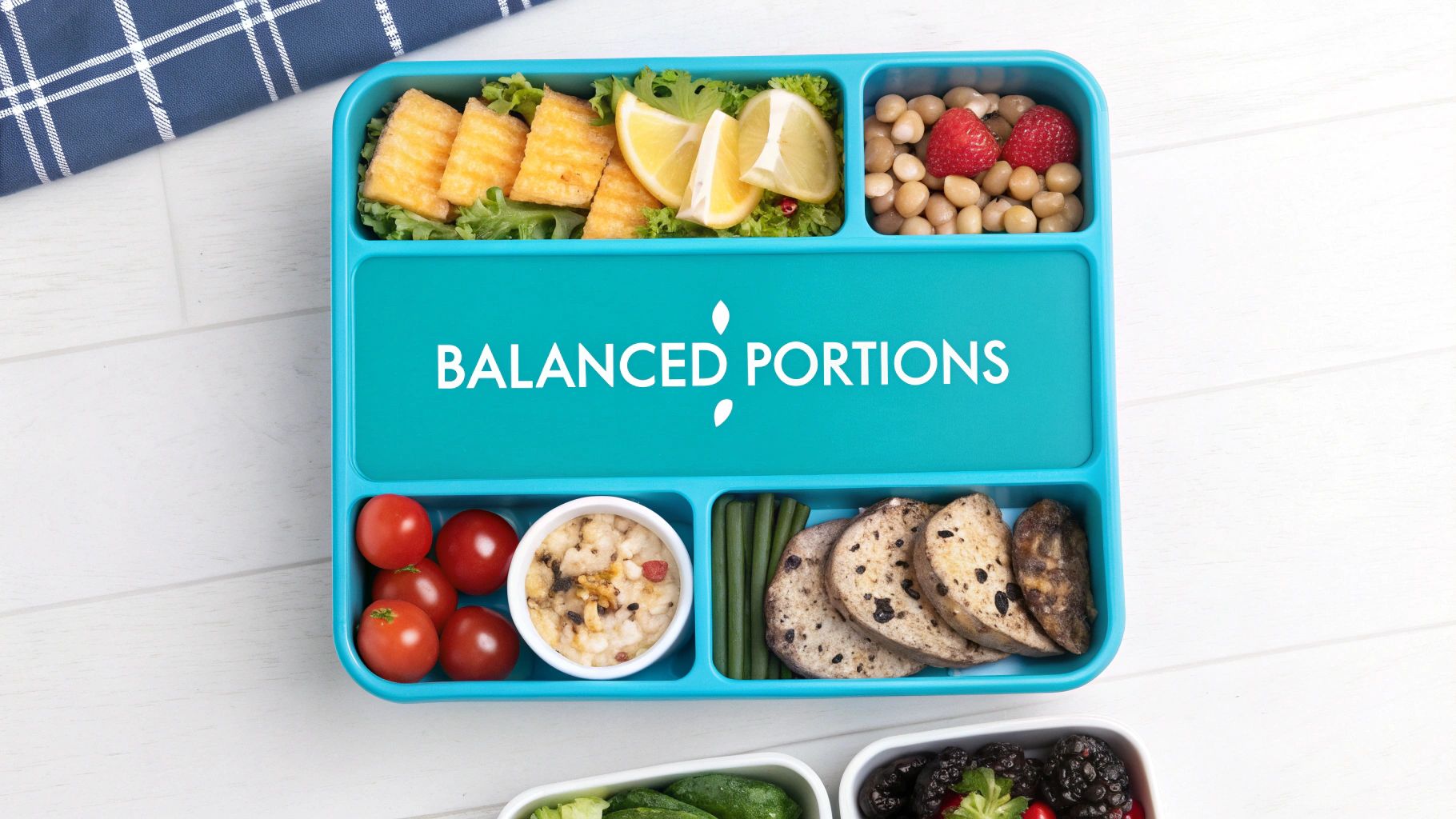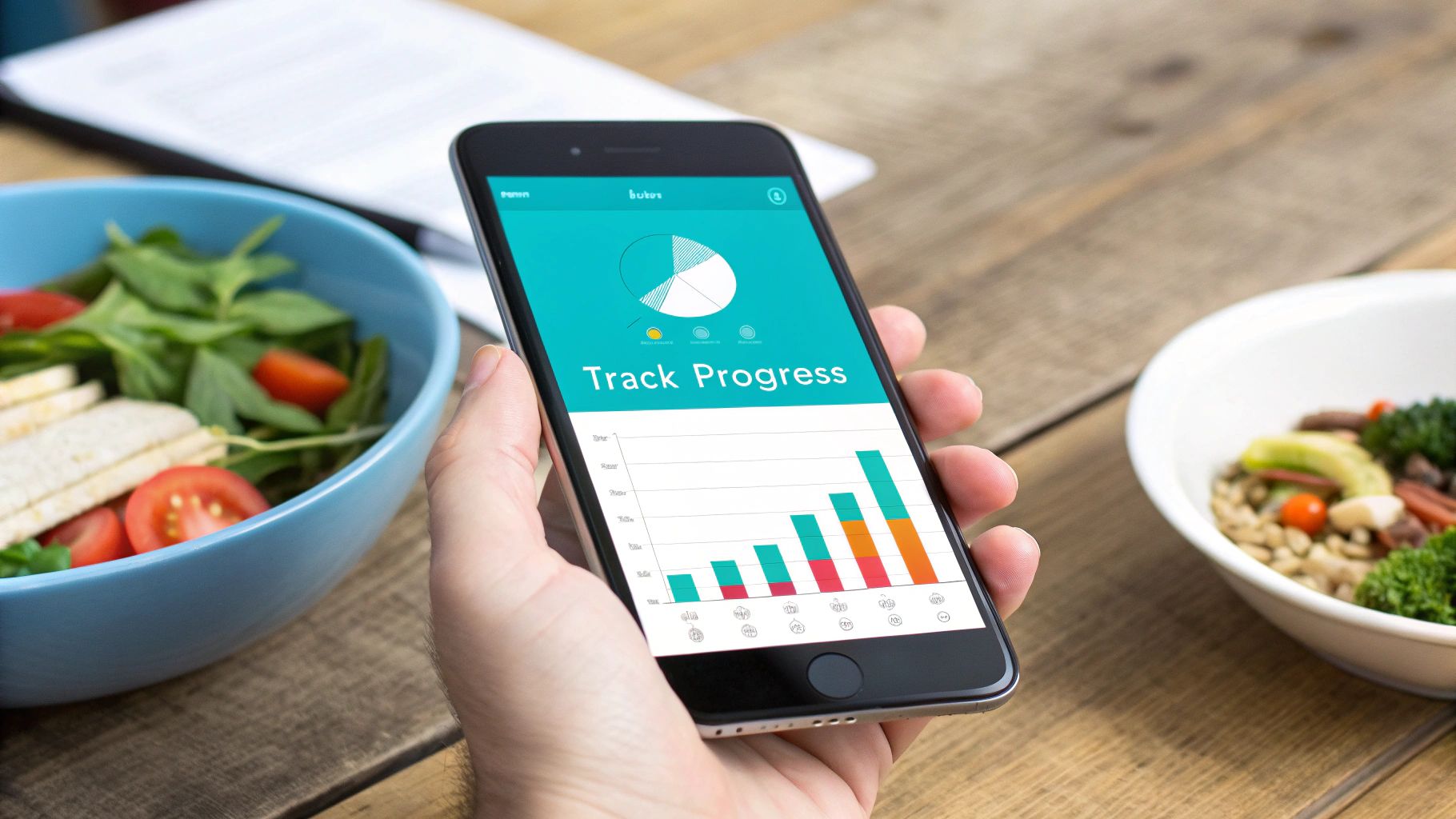How to Count Macros for Weight Loss: Proven Tips
Ready to take control of your weight loss journey? Let's explore macronutrients - the essential building blocks that make up your diet. While calories tell you how much energy is in your food, macros tell you where that energy comes from. Understanding the roles of proteins, carbohydrates, and fats is your key to sustainable weight loss success. If you want to fastrak your dream body - Join KOVA Method to rapidly lose fat & gain muscle in half the time with their revolutionary Fat Loss Sprints, Flexible Dieting & Hybrid Cross training methods. Formulated by former NFL athlete Khairi Fortt & Expert Fitness Coach Chase Garcia, 100s of women have finally transformed their lives.
Understanding Macros: Your Weight Loss Foundation

The Power of Protein
Think of protein as your body's building blocks and repair crew. It helps maintain and build muscle tissue, which is fantastic news for weight loss - the more muscle you have, the more calories you burn, even while resting! Picture your metabolism like a furnace that burns hotter when you feed it enough protein. By getting adequate protein in your diet, you're not just protecting your muscles during weight loss - you're giving your metabolism a natural boost.
Carbohydrates: Fueling Your Body
Just like your car needs the right fuel to run smoothly, your body needs quality carbohydrates for energy. The key is choosing the right type. Complex carbohydrates from whole grains, fruits and vegetables are your premium fuel - they provide steady energy and pack lots of nutrients. Skip the simple carbohydrates found in sugary treats and processed foods - they'll leave you feeling sluggish and hungry soon after eating.
Healthy Fats: Essential for Wellness
Don't let the word "fat" scare you! Healthy fats are your friends when it comes to weight loss. They help your body absorb nutrients, produce important hormones, and keep you feeling satisfied after meals. Get your healthy fats from foods like avocados, nuts, seeds and olive oil. These fats are crucial for both your health and weight loss success.
The Macro Approach: A More Nuanced Strategy
Rather than just counting calories, tracking macros gives you deeper insight into your nutrition. A typical macro split for weight loss looks like this: 40-60% carbohydrates, 15-35% protein, and 20-40% fat. This balanced approach lets you create an eating plan that works for your unique needs. Want to learn more? Check out Precision Nutrition for detailed guidance. By understanding what your food is made of - not just how many calories it contains - you can make smarter choices that support lasting weight loss. The macro approach helps you build sustainable eating habits while nourishing your body properly.
Calculating Your Perfect Macro Balance
Getting your macro ratios right is key to successful weight loss. Rather than following generic recommendations, you need personalized calculations based on your unique body and goals. In this section, I'll walk you through how top nutrition coaches determine ideal macro splits to maximize fat burning while keeping muscle intact.
Determining Your Total Daily Energy Expenditure (TDEE)
The first step is finding your Total Daily Energy Expenditure (TDEE) - the total calories you burn daily. This combines your Basal Metabolic Rate (BMR) (calories burned at rest), physical activity, and the energy used digesting food. You can easily estimate your TDEE using online calculators that factor in your stats and lifestyle.
Establishing a Calorie Deficit for Weight Loss
Once you know your TDEE, create a moderate calorie deficit. A sweet spot is 500-750 fewer calories per day, which leads to 1-1.5 pounds of fat loss weekly. This pace helps protect muscle while steadily dropping fat. Going too aggressive with calories can backfire by breaking down muscle and slowing metabolism. Balance is key!
Setting Your Macro Ratios
Next comes dialing in your macro percentages. While 40% carbs, 30% protein, and 30% fat is a good starting template, you'll want to adjust based on your needs and response. Active folks often do better with extra carbs for workout fuel. The research shows personalization matters - for example, a McMaster University study found 50% carbs, 35% protein, and 15% fat worked great for fat loss. Check out the full research for more insights on optimizing your ratios.
Here's a handy comparison of recommended macro splits for different goals:
| Goal | Carbs % | Protein % | Fat % | Best For |
|---|---|---|---|---|
| Fat Loss | 40-50% | 30-35% | 20-25% | General weight loss |
| Muscle Gain | 45-55% | 25-35% | 20-25% | Building size/strength |
| Low Carb | 20-30% | 35-45% | 30-40% | Insulin sensitivity |
| Maintenance | 45-55% | 25-30% | 25-30% | Weight stability |
Calculating Your Macros in Grams
Time to convert percentages into actual food amounts! Multiply your daily calorie target by each macro percentage, then divide by calories per gram (4 calories/gram for carbs and protein, 9 calories/gram for fat). For example, on 1800 calories with 30% protein, you'd eat (1800 x 0.30) / 4 = 135 grams protein daily.
Fine-Tuning Your Macros
Your perfect macro mix will evolve as your body changes. Pay attention to energy, hunger, and workout performance to gauge when tweaks are needed. Regular check-ins and adjustments ensure your nutrition keeps driving results. Stay flexible and let your progress guide macro updates over time.
Choosing Quality Sources for Maximum Impact

Now that we've covered macro calculations, let's explore how to select the best food sources. Getting your macro numbers right is just the start - choosing nutrient-rich foods that properly fuel your body is what really drives results. The quality of your food choices directly impacts your energy, hunger levels, and ultimately your weight loss success.
The Importance of Nutrient Density
Picture two meals with identical macro counts: one made from processed snacks, the other from whole foods like grilled chicken, quinoa and vegetables. While the numbers match up, their effects on your body are worlds apart. The whole foods meal gives you steady energy and keeps you satisfied for hours. The processed meal? Quick energy spikes followed by crashes and cravings. This shows why looking beyond just the macro numbers is so important.
Optimal Sources of Macronutrients
Make your macro counting count by choosing high-quality sources. For protein, go for options like lean meats, fish, eggs, legumes and tofu that support muscle health without excess fats. Choose carbohydrates like brown rice, sweet potatoes, and plenty of fruits and vegetables - these provide lasting energy plus filling fiber. Include healthy fats from foods like avocados, nuts, olive oil and fatty fish that support vital body functions.
Building Satisfying and Macro-Friendly Meals
The key is combining quality protein, carbs and fats into balanced, delicious meals that keep you on track. A perfect example: grilled chicken breast with brown rice and roasted broccoli drizzled with olive oil. This gives you all three macros in a satisfying way that supports your goals. Understanding food quality is crucial - consuming 2,000 to 2,500 calories of mostly refined carbs won't get you the same results as nutrient-dense whole foods. Learn more about macronutrients on Cedars-Sinai's blog.
Practical Tips for Choosing Quality Food Sources
Making smart food choices becomes second nature with these strategies: Plan your meals ahead to avoid impulse decisions. Focus on whole, minimally processed foods. Shop the store perimeter where fresh ingredients live. Keep healthy staples on hand for quick meals. These simple habits help you take control of your nutrition and create lasting changes that stick.
Master Your Macro Tracking Game
Want to crush your weight loss goals through macro counting? You'll need more than just numbers - you need smart strategies and practical tools to make tracking a natural part of your routine. Let's dive into proven techniques that will help you stay consistent and overcome common challenges.
Making Tracking Simple and Sustainable
Gone are the days of complicated food journals! Modern tracking apps make it super easy to log your meals and keep tabs on your macros. These handy tools give you instant insights into your nutrition and help you stay accountable.
Let's compare some of the best macro tracking apps out there:
| App Name | Key Features | User Rating | Price | Best For |
|---|---|---|---|---|
| MyFitnessPal | Extensive food database, barcode scanner, recipe logging | 4.5 stars | Free, Premium option available | Beginners and experienced trackers |
| Lose It! | Calorie and macro tracking, personalized weight loss plans, community support | 4.2 stars | Free, Premium option available | Goal-oriented individuals |
| Cronometer | Detailed nutrition information, custom biometrics tracking, recipe analysis | 4.6 stars | Free, Gold subscription available | Health-conscious users |
| MacroFactor | Advanced macro adjustments, data-driven insights, personalized coaching | 4.7 stars | Paid subscription | Serious athletes and those seeking in-depth analysis |
Finding your perfect app match makes tracking feel like second nature rather than a chore. The right tool can make all the difference in staying consistent.
Meal Prep and Planning: Your Secret Weapons
Meal prepping is your best friend when it comes to accurate macro tracking. By preparing meals ahead of time, you're in complete control of ingredients and portions. Plus, you'll save tons of time and avoid those unhealthy last-minute food choices.
Weekly meal planning ensures you always have macro-friendly options ready to go, even during your busiest days. For women juggling work, family, and fitness goals, having a solid plan is a total game-changer. Think of it as your nutrition roadmap to success!
Dining Out Without Stress
You can absolutely enjoy restaurants and social events while staying on track with your macros! Many restaurants now post their nutrition info online - use this to plan ahead. Don't hesitate to ask servers about ingredients or request modifications to better fit your goals.
At social gatherings, focus on making smart choices when possible. If options are limited, prioritize protein and healthy fats to stay satisfied and avoid overdoing it on less nutritious foods. Remember: progress over perfection!
Rolling With Life's Curveballs
Let's be real - life doesn't always go according to plan. Maybe you're traveling, dealing with a crazy work week, or hitting a plateau in your progress. The key is staying flexible and adjusting your approach as needed. If you miss a few tracking days, no worries! Just hop back on track when you can. Having trouble with cravings? Explore healthy alternatives that satisfy those urges while keeping your macros in check.
When you view macro tracking as a sustainable lifestyle rather than a quick fix, you'll be much better equipped to handle any obstacles that pop up along the way. This mindset shift is what leads to lasting success with your weight loss journey.
Overcoming Common Macro Counting Challenges

Getting your macro counts right is essential for weight loss success. But let's be real - life happens! From social events to busy schedules, staying on track with your macros can be challenging. The good news? With the right mindset and strategies, you can overcome these bumps in the road.
Conquering Cravings
Got a sweet tooth calling your name? Don't fight it - work with it! When chocolate cravings hit, try pairing a small piece of dark chocolate with protein-rich almonds. This smart combo satisfies your craving while keeping your macros in check. The real win? Focusing on whole foods naturally reduces cravings by keeping you energized and satisfied longer.
Navigating Social Events
Don't let parties derail your progress! Here's a game-changing tip: eat a balanced snack before heading out. This puts you in control, so you can make clear-headed food choices instead of diving into the buffet ravenous. Better yet, bring a macro-friendly dish to share - you'll be everyone's favorite guest while sticking to your goals!
Staying on Track While Traveling
Pack smart and stay ahead of the game when you're on the road. Stock up on portable snacks like nuts and protein bars for those times when healthy options are hard to find. If you're staying somewhere with a kitchen, grab some groceries and whip up simple meals. Want to learn more about finding the right macro balance? Check out this great guide on macro ratios for weight loss.
Managing Plateaus and Stress Eating
Hit a plateau? Think of it as your body's way of asking for a change-up! Sometimes a small adjustment to your macro split is all you need to kickstart progress again. And when stress has you reaching for comfort food, remember that a quick walk or meditation session might be what you really need. Your success depends on building healthy ways to handle life's challenges.
Making Macro Counting Sustainable
Here's the thing about macro counting - it gets easier! Instead of seeing it as a strict diet, think of it as your personal nutrition guide. Focus on these three pillars: consistency, flexibility, and whole foods. The Kova Method shows you how to achieve lasting results while actually enjoying your food. With practice and patience, you'll find your groove and crush those weight loss goals!
Making Macro Counting Your Lifestyle

You've got your macro calculations down and know how to choose quality foods. Now comes the exciting part - making macro counting an effortless part of your daily life! This isn't about strict rules or restrictions. It's about creating simple habits that help you reach your goals while still enjoying food and having fun.
Shifting Your Mindset: From Diet to Lifestyle
Think of macro counting as your personal nutrition guide, not a temporary fix. It helps you understand exactly what your body needs to feel and perform its best. Instead of labeling foods as "good" or "bad," focus on including lots of nutritious options that fit your macro targets. This positive mindset makes healthy eating feel natural and sustainable. Fortunately at KOVA Method, you don’t need to count every macro to see quick results - we only follow 2 metrics. Join our community and you’ll see why this will be the last program you’ll ever need.
Maintaining Momentum and Motivation
The proof is in the results - **countless people** who've made macro counting their lifestyle report amazing benefits like lasting weight loss, steady energy, and newfound body confidence. The key? Focus on progress over perfection. If you slip up, just get right back on track at your next meal. Having supportive friends or an online community can make a huge difference in staying motivated for the long haul.
Adapting to Life's Changes
Life throws curveballs - vacations, busy work weeks, family commitments. Your macro approach should flex with these changes. Maybe you adjust your targets during slower periods or simplify meal prep when things get hectic. The goal is finding what works for your real life, not perfection. Stay consistent when you can while being flexible when needed.
Thriving in Maintenance Mode
Once you hit your goal weight, macro counting becomes your secret weapon for keeping those results. Rather than ditching it completely, adjust your numbers to maintain your new healthy weight. This gives you an easy framework for making smart food choices and prevents falling back into old habits that led to weight gain.
Building Lasting Healthy Habits
Macro counting naturally leads to other positive changes. When you focus on nutritious, balanced meals, you start craving foods that make you feel great. This often inspires other healthy choices like regular exercise, quality sleep, and stress management. Together, these habits create lasting change that goes way beyond the scale.
Ready to transform your body and build lasting confidence? The **Kova Method** empowers women to achieve sustainable weight loss through science-backed fat loss strategies and food and supplement hacks that get you sexy and toned in half the time. Learn more and start your journey today: [Kova Method Website](https://www.kovamethod.com)
